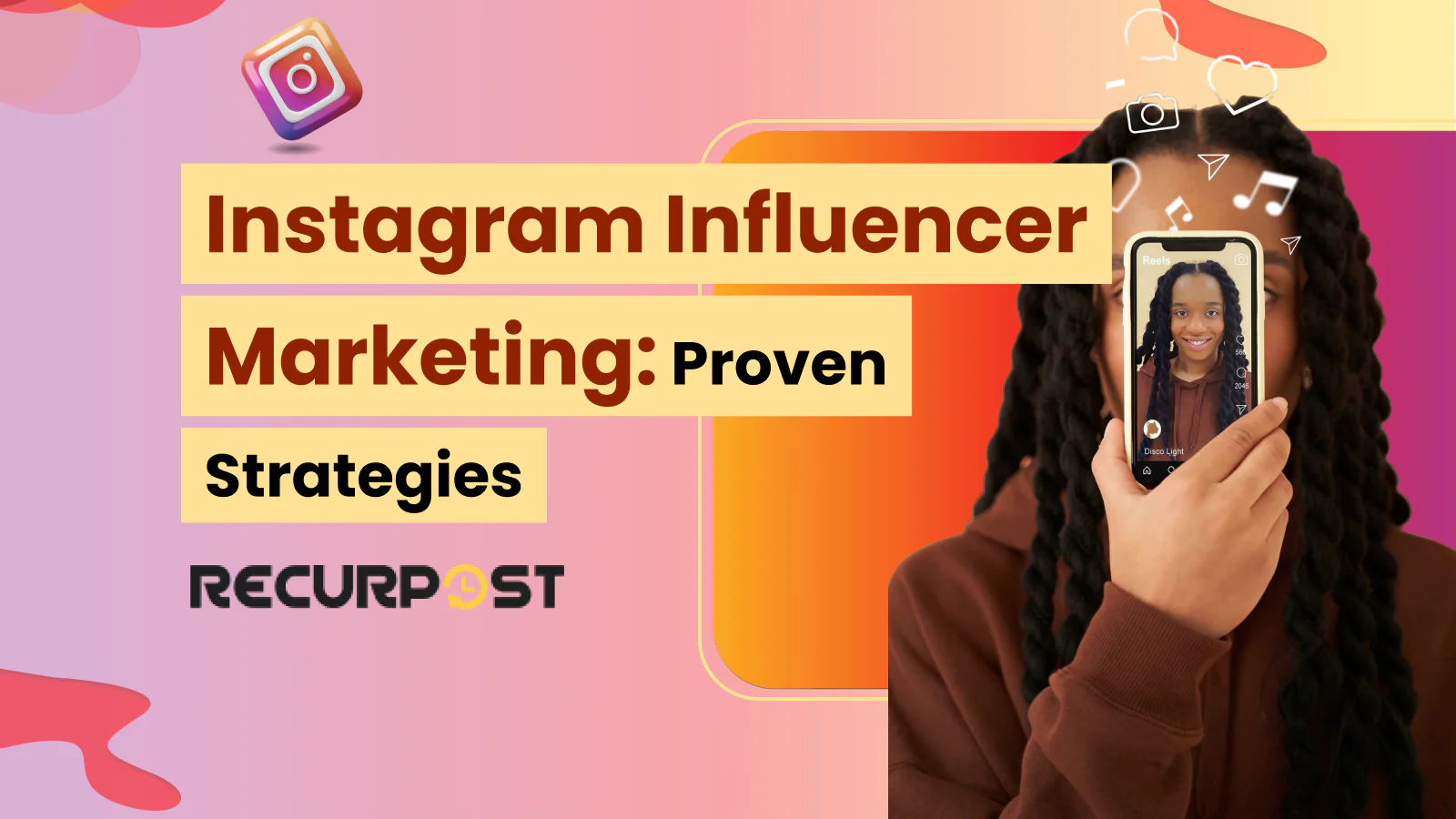Instagram influencer marketing connects brands with content creators who have established Instagram audiences to promote products through authentic posts, Stories, and Reels that leverage follower trust. which works by connecting brands with engaged audiences through creator-generated content that drives product discovery and purchasing decisions. The industry, valued at over $32 billion globally, transforms product discovery, purchasing decisions, and brand loyalty development.
Instagram combines product discovery, storytelling, and community building in one platform. Statista reports that nearly 69% of shoppers trust influencer suggestions when deciding what to buy, showing audiences prefer creator content over traditional ads.
You’ll learn
- How Instagram influencer marketing has evolved and why it’s effective
- How to choose the right Instagram influencers for your goals
- Budgeting methods that maximize returns
- Data-driven strategies for better ROI
- Benefits of Instagram creator marketing
- The most important trends for 2025
An effective Instagram influencer marketing strategy requires clear campaign objectives, identified target audiences, aligned creators, realistic budgets, and tracking systems measuring engagement and conversion metrics.
Marketing has evolved from celebrity faces on billboards and TV s
Instagram functions as a digital marketplace where users build trust through scrolling Stories, Reels, and posts containing recommendations from creators they follow. The platform operates visually, persuasively, and socially.
Instagram blends entertainment with commerce in ways few platforms can, making it valuable for brand conversations because:
- People are already in discovery mode: Users tapping through hashtags or browsing Explore come with curiosity, making them receptive to product recommendations from trusted creators.
- No app-hopping needed: Shoppable tags enable users to see, like, and buy products within seconds without switching platforms.
- Multiple content formats = more storytelling freedom: Short Reels, disappearing Stories, and saved carousels give brands multiple storytelling options.
Want your posts to stand out? Check out our Content Creation Guide for Social Media packed with ideas to help you create content that connects and converts.
Did you know? 61% of users head to Instagram when they’re thinking about their next purchase (Sprout Social). That’s higher than Facebook or Twitter.
Instagram Hashtag Generator for Influencers
Get noticed by the right audience with AI-curated, influencer-specific hashtags.
This free tool generates high-performing hashtags tailored to your niche—whether you’re in fashion, fitness, beauty, travel, or lifestyle. Just drop your topic, and AI does the rest.
⭐ 4.3/5 average user rating (based on 2,000+ reviews)
“I finally reached the right audience—my engagement jumped in just a few posts.” – Lifestyle Influencer
From Celebrity Promos to Creator-Led Storytelling
Marketing has shifted from celebrity faces on billboards and TV spots to creators leading brand advocacy in 2025. Followers relate more to creators who share authentic product experiences as everyday people rather than spokespeople.
Influencer content now appears as authentic recommendations rather than paid promotions. Content from creators with small but loyal audiences sharing products in their voice creates personal connections rather than promotional messaging.
Instagram influencer marketing best practices include authentic storytelling over polished advertisements, selecting creators based on audience alignment rather than follower count, fostering long-term partnerships for genuine brand advocacy, and maintaining transparency through disclosure tags like #ad or #sponsored. which enables brands to use influencer marketing on Instagram through authentic creator relationships that build trust and drive conversions. And Instagram is where those stories thrive.
"People buy from people they trust, not the loudest voice in the room, but the most relatable one."
Micro influencers and Nano influencers, though smaller in reach, drive higher consumer trust and long-term brand relationships because their tightly-knit communities make recommendations feel personal.
ROI Insights: Micro and nano influencers deliver better ROAS (Return on Ad Spend) through lower costs and higher engagement rates. Brands working with nano influencers see up to 60% increased community response versus celebrity partnerships, increasing brand value.
2025 Trend Alert: AI-powered influencer matchmaking platforms identify creators with high campaign ROIs, niche relevance, and audience sentiment alignment. Upfluence, Julius, and Modash use machine learning to suggest optimal creator-brand fits based on campaign goals.
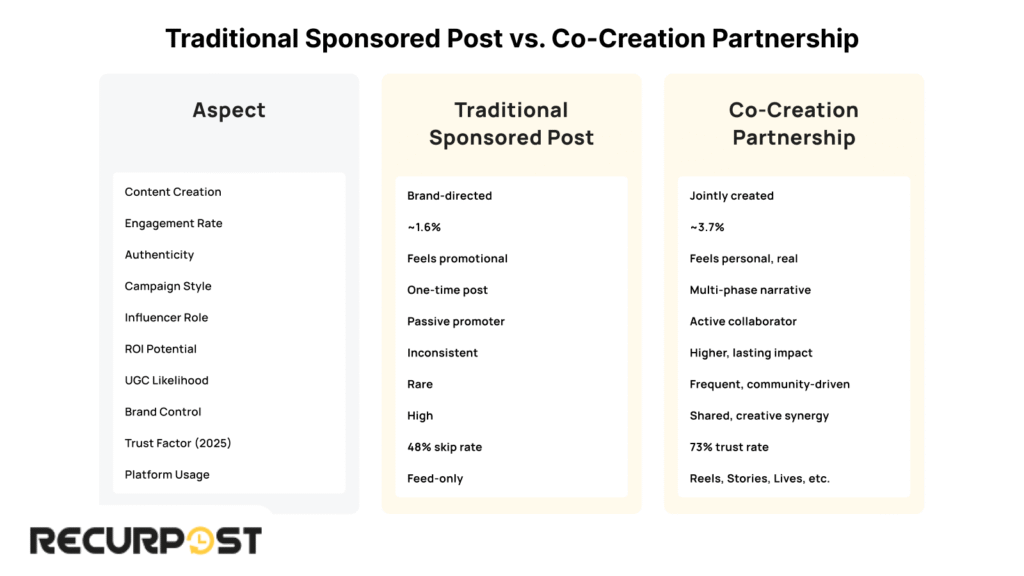
This evolution in trust and technology sets the stage for the next vital move: choosing the right influencer partner for your campaign, because fit always beats fame.
Choosing the Right Instagram Influencer: Why Strategic Fit Matters
Influencer relatability builds trust, but strategic fit drives campaign success. Partnering with mismatched influencers damages reputation, confuses messaging, and attracts non-converting followers. Well-matched partnerships generate stronger engagement, expanded reach, and meaningful conversions.
Instagram Influencer Tiers and Their Strategic Purpose
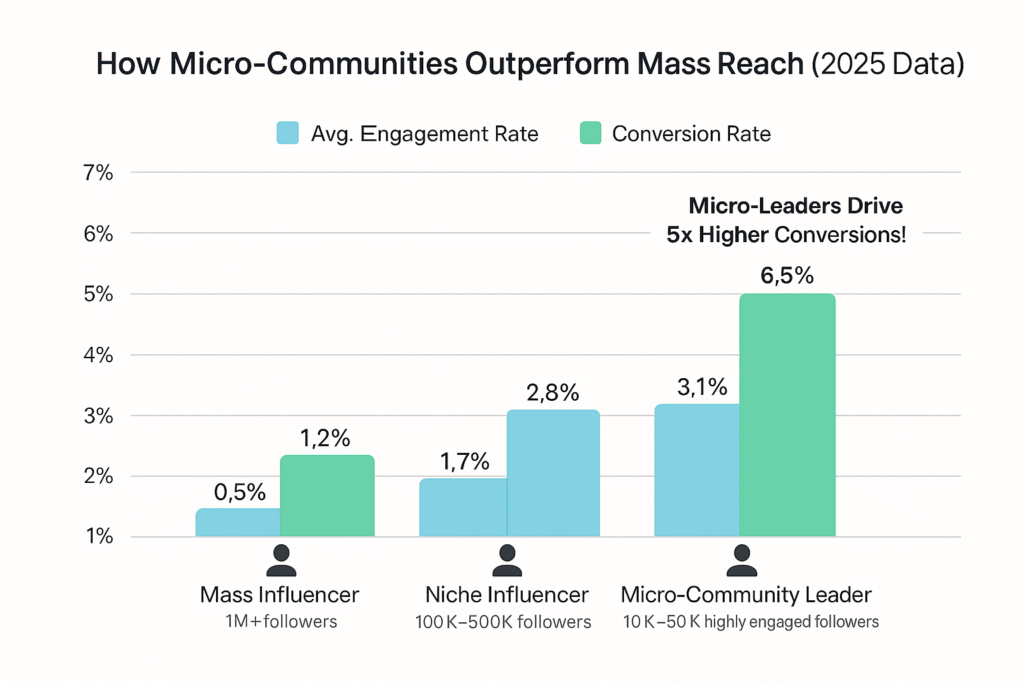
Influencers group into different tiers based on follower count, but quantity doesn’t equal quality. Focus on fit, focus, and function when selecting partners.
Tier | Follower Count | Ideal Use Case |
Nano Influencers | 1K–10K | Hyper-local reach, niche audiences |
Micro Influencers | 10K–100K | High engagement, authentic content |
Macro Influencers | 100K–1M | Industry authority, moderate reach |
Mega/ Celebrity Influencers | 1M+ | Brand awareness, large-scale buzz |
This approach doesn’t just stretch your budget; it also improves your chances of creating genuine customer relationships. Selecting influencers based on audience relevance and content quality, not just numbers, becomes a powerful growth lever.
Evaluating Instagram Influencer Authenticity and Audience Relevance
Selecting appropriate influencers goes beyond follower metrics. Evaluation should examine influencer-audience interactions, follower alignment with your customer base, and past content consistency with your brand values.
When marketing a vegan snack, an influencer who recently promoted non-vegan products creates a mismatch, making your campaign feel off-brand. Despite their following size, their audience might distrust the endorsement, reducing your conversion potential.
Tools like Upfluence, Heepsy, and Modash evaluate creators using data on audience makeup, real engagement, previous brand deals, and warning signs like fake followers or inconsistent messaging.
Finding and Vetting Instagram Influencers: A Proven Selection Process
Selecting Instagram influencers requires prioritizing audience connection over follower count. Well-matched creators drive campaign success, while poorly chosen partnerships waste budget without generating results. Data backs this up: micro-influencers who are chosen based on fit and engagement can drive up to 60% higher interaction rates compared to random selections.
Creating and managing Instagram influencer campaigns involves using specialized platforms—like Heepsy for discovering creators, Upfluence for fraud detection, and Aspire for full campaign management, which streamlines everything from outreach and contract negotiation to content approval and performance tracking through systematic campaign workflows.
Tool | Best For | Features |
Finding Niche Creators | Demographics, Engagement analysis, Location filter | |
Avoiding fake followers | AI-powered fraud detection, influencer credibility | |
End-To-End influencer campaign | Influencer outreach, Relationship management, Contract workflow | |
Vetting influencers across platforms | Real-time audience quality, Tik-Tok + IG integration | |
Content discovery and trend analysis | Identifies top-performing content and influencers within your niche | |
Small businesses and startups | Affordable plans, influencer marketplace, and automated campaign tools | |
Enterprise-level campaign management | CRM features, ROI tracking, and advanced analytics |
Instagram influencer marketing tools range from free discovery platforms to enterprise-level campaign management systems, with most offering features like creator vetting, audience analytics, contract management, and ROI tracking that automate previously manual processes, which provide data-driven insights for campaign optimization through platforms like Heepsy, Upfluence, and Aspire.
Influencer marketing tools offer data-driven insights, including audience demographics and engagement quality metrics, allowing informed partnership decisions.
After assembling your creator team, create a strategic budget that prioritizes measurable returns beyond engagement metrics.
Tip: Want to compare the best influencer marketing tools in one place? Check out our full breakdown to find what fits your brand (and budget).
How to Discover the Right Instagram Influencers
Finding influencers who produce results for your brand requires strategic selection from Instagram’s vast creator ecosystem. Here are four proven ways to uncover influencers who deliver:
1. Hashtag Scouting
Browse hashtags your audience follows like #CrueltyFreeBeauty or #HomeFitnessTips. Find creators posting consistently with genuine interactions and thoughtful comments beyond emoji spam, indicating real, engaged communities.
Here are a few hashtag examples by niche:
- Fashion:
#styleinspo,#ootd,#fashionblogger - Beauty:
#beautytips,#skincareroutine,#makeuptutorial - Tech:
#techreview,#gadgetlover,#techtips - Fitness:
#workoutroutine,#fitnessmotivation,#healthylifestyle
2. Competitor Check
Examine competitors’ tagged posts or brand mentions. Creators partnered with competitors already know your space and may match your brand. Check for exclusivity clauses before outreach.
3. Influencer Platforms
Building Instagram influencer networks uses discovery platforms like Modash, Heepsy, or Upfluence to browse creators by niche and location while leveraging hashtag research, competitor analysis, and Instagram’s algorithms to identify partners aligning with brand values and target demographics. These tools examine engagement quality, past brand work, and fake follower indicators.campaigns and authentic brand advocacy.
Here’s a quick comparison:
| Platform | Profiles Available | Best For |
|---|---|---|
| Upfluence | 3M+ | All industries |
| AspireIQ | 500K+ | Lifestyle, fashion |
| Tagger | 6M+ | Global influencer reach |
| Grin | 100M+ | eCommerce brands |
These tools save time when managing multiple campaigns or scaling operations despite their cost.
4. Instagram Suggestions
Instagram’s recommendations show similar profiles through “Suggested for You” after following niche creators. These AI-driven suggestions uncover up to 35% more relevant influencers than standard database searches.
Not All Influencers Are a Good Fit — How to Vet Them Before You Commit
Assess potential partners through this five-part filter to prevent budget waste, brand inconsistencies, and campaign failures.
Look for a Real Audience (Not Just Big Numbers)
Bots and fake engagement remain prevalent—avoid surface-level statistics.
- Engagement ratio: Healthy ranges sit between 1:3 and 1:6 (one like/comment per 3–6 followers).
- Growth curve: Use tools like SocialBlade to check if their following grew steadily or spiked overnight.
- Comment quality: Are followers dropping real thoughts or just emojis?
- Red flag: Over 10K followers with under 1% engagement? Probably not a real influence.
Judge the Content (Not Just the Aesthetic)
You’re not just renting space, you’re using someone’s voice. Make sure it doesn’t clash with yours.
- Is their visual style at least an 80% match with your brand?
- Do their captions sound personal, not robotic?
- Are their Reels and Stories engaging or just filler?
Tip: Reels usually pull 2.3x more engagement than static posts. Compare how they perform across formats.
Double-Check Brand Safety and Value Match
One misaligned post can derail your entire campaign, making thorough vetting essential.
- Review the last 6 months of their posts for anything off-brand or controversial.
- Rate value alignment with your brand from 1 to 10; your gut counts.
- Have they recently promoted a competitor? If yes, tread carefully.
- Scroll through their comments, are they trusted, or does it feel off?
Ask for the Numbers That Matter
Request platform-verified performance statistics with context rather than glossy screenshots.
- Ask for platform-verified performance stats.
- A solid reach-to-follower ratio is around 30%+.
- Instagram influencer conversion rates typically achieve 70%+ completion for Stories
- 1.5–3% click-through rates on branded links, which represent standard performance benchmarks
Look Into Past Partnerships
An influencer’s collaboration track record demonstrates their creative partnership capabilities.
- Review at least five recent brand collabs.
- Message 2–3 past brands (if possible) for honest feedback.
- Were deadlines met? Did the content match the brief?
- Did they bring fresh ideas or go off-brand?
Instagram Influencer Outreach Process
Approaching influencers as creative collaborators rather than transactional partners increases response rates by 68% when following this 4-step outreach sequence.
Step 1: Warm Up With Intentional Engagement
Before messaging someone, make sure you’ve shown up in their space.
Interact with 3–5 of their posts over a week or so, leave meaningful comments, share something on Stories, or respond to their content with something real. Skip the “fire” and say something thoughtful.
This kind of low-key interaction builds familiarity, so when you message them, you’re not just another brand request; they already know your name.
Step 2: Send a DM That Feels Human
Now that you’re on their radar, send a personalized direct message. Make it casual and to the point. Mention something specific they posted that stood out to you.
Here’s a simple message you can tweak:
DM Template:
Hi [Name], I’m [Your Name] from [Brand]. I enjoyed your recent post about [insert specific post or topic]—loved how you [compliment or comment].
We’re looking for creators to help showcase our [product/service], and your authentic style feels like a perfect match. Would you be open to chatting more about it? Happy to send details or switch to email if you prefer.
Step 3: Follow Up with a Formal Proposal
Once they reply with interest, move the conversation to email—it’s easier to keep things organized and professional.
In your first message, include the essentials:
- What the campaign’s about: Share your goal, core message, and why you think they’re a great fit.
- Deliverables: Spell out what you’re looking for—like 2 Reels + 3 Stories, or 1 carousel post + 1 Story with link.
- Compensation: Be upfront. Whether it’s a flat fee, affiliate bonus, gifted product, or a mix, clarity builds trust.
- Timeline: Set expectations for drafts, posting dates, and reporting windows.
- Creative direction: Include must-haves like tone, style, hashtags, visual vibe, or what to avoid.
- Performance expectations: Define what success looks like so everyone’s on the same page.
Keep the tone warm and collaborative.
Step 4: Finalize It with a Contract + Quick Onboarding
Once they’re in, get everything in writing. A well-drafted agreement makes things clear and prevents miscommunication. Document all agreements in writing to maintain clarity and prevent miscommunication. Once they’re in, get everything in writing. A well-drafted agreement makes things clear and prevents miscommunication.
Key details to include:
- Usage rights: 76% of brands now ask for at least 6 months of content usage—state your expectations up front.
- Payment terms: For example, 50% upfront, 50% on delivery.
- Exclusivity: If you want them to hold off on promoting similar brands during the campaign, say so.
- Content ownership: Can you reuse their content in ads or on your site? Make that clear.
- FTC compliance: Make sure they tag posts correctly with #ad, #sponsored, or use branded content tools as needed.
Bonus tip: Include a short onboarding doc or record a quick Loom video walking them through the next steps. It reduces back-and-forth and helps creators feel confident, aligned, and ready to create.
“Without data, you're just another person with an opinion.” — W. Edwards Deming.
Calculate Instagram Influencer Marketing Cost Like a Pro
Why Budgeting Can Make or Break Your Influencer Campaign?
Brands often mistakenly focus on only the post fees when budgeting for influencer marketing. Brands often mistakenly focus on only the post fees when budgeting for influencer marketing.
Improper budgeting risks overspending on underperforming creators or missing opportunities with high-performing influencers through insufficient allocation.
What happens when you plan your budget well:
- Campaign performance becomes more predictable
- ROI improves because your spending is better balanced
- You can communicate numbers clearly with your team or clients
- Scaling future campaigns feels less risky and more manageable
What happens when you don’t:
- You burn through money with no clear results
- You pick influencers who don’t move the needle
- It’s harder to explain where the money went (and why)
- Mid-campaign course correction becomes messy or impossible
Smart budgeting leads to:
- Better choices backed by metrics like CPE (Cost per Engagement) and ROMI (Return on Marketing Investment)
- Thoughtful spending across influencer tiers—not all your eggs in one basket
- Room to test trends like Reels, seasonal formats, or giveaways
- Long-term savings through smart tools and automation
Bottom line: Budgeting isn’t just about controlling costs; it’s what gives your entire campaign structure, clarity, and staying power. Ensures your content-driven brand promotion delivers results that matter.
Build a Data-Driven Instagram Influencer Marketing Strategy That Converts
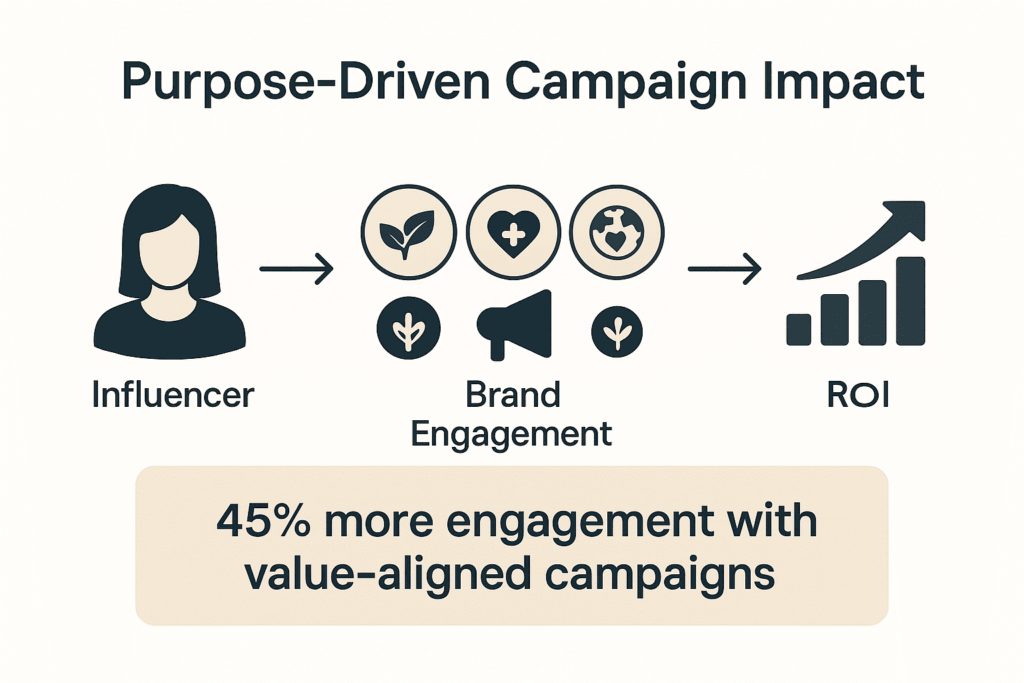
Don’t Just Post—Plan With Purpose
Successful Instagram influencer campaigns require solid planning and performance tracking instead of guesswork.
Campaigns must connect to measurable outcomes like awareness generation, product sales, list growth, or app installs with a defined purpose and success metrics.
Start With a Clear Goal (Tied to Business Outcomes)
Before shortlisting creators, ask yourself:
- Launching something new or breathing life into an existing offer?
- Looking to drive traffic, boost conversions, or build social credibility?
- Is this a sprint (one-off campaign) or a long-term brand play?
Examples of Real Goals That Work
- Increase site visits by 25% in 30 days
- Hit a 4% engagement rate on sponsored posts
- Get 500 new email sign-ups via Story links
- Drive 100 sales using a creator-specific discount code
Then, Track the Right KPIs
Your goals define your metrics:
- Reach / Impressions – How many people saw the content?
- Engagement – Likes, comments, shares, saves—did it resonate?
- Click-Through Rate (CTR) – Did people take the next step?
- Conversion Rate – Did they sign up, buy, or download?
- ROI / ROAS – Was it worth it financially?
Defined targets and metrics direct creator selection, content development, and budget allocation beyond performance tracking.

Choose no more than 2–3 core metrics per campaign. Trying to track everything can lead to analysis paralysis.
Choose the Right Content Format (Reels, Stories, Carousel)
Instagram content formats serve different funnel purposes, with successful campaigns aligning goals, influencers, and formats for optimal results.
Format | Best For | Why It Works |
Reels | Reach, virality, engagement | Short-form, algorithm-friendly, highly shareable |
Stories | Direct traffic, limited-time offers | Swipe-ups, polls, urgency, great for CTAs |
Carousels | Education, tutorials, product showcases | More space for storytelling and product info |
Lives | Deep engagement, Q&A, launches | Real-time connection builds trust and community |
2025 Insight: Reels with a CTA in the first 3 seconds deliver 27% higher interaction level than those that don’t. Keep your call to action short, visual, and early.
Use UTM Links, Discount Codes & Hashtag Tracking
Track What Works, Drop What Doesn’t
Data-driven decisions scale while intuition-based approaches lead to costly mistakes without proper tracking.
Use these tools to see what’s moving the needle:
- UTM links to trace clicks from each influencer
- Branded hashtags to monitor campaign buzz and user-generated content
- Unique promo codes to tie purchases back to individual creators
- Instagram Insights or dashboards like Later, RecurPost, or HypeAuditor to compare performance side by side
Real-world scenario:
Influencer A racks up likes but few sales. Influencer B gets fewer hearts but drives 10x the checkouts. That’s not just a preference’s profit. Reinvest where the action is.
“Marketing without data is just guessing with budget.”
Squeeze More Value From Great Content
High-performing influencer posts shouldn’t disappear after 24 hours. Reuse them to consistency and maximize returns:
- Turn them into Facebook or Instagram ads
- Feature in product pages or landing banners
- Use as email headers or scroll-stopping CTAs
- Repost with new captions, angles, or offers
Instagram influencer product promotion creates authentic partnerships where creators showcase products naturally in posts and Stories using unique discount codes and trackable links for sales attribution measurement while repurposing content across marketing channels.

Always negotiate content usage rights before the campaign starts. This allows you to reuse influencer content legally in paid media or branded placements.
What’s Working for Successful Influencer Marketing: Less Promotion, More Participation
Instagram and audience responses to branded content change continuously, making 2022 sponsored post strategies obsolete in 2025.
Brands succeed in 2025 by building authentic creator partnerships rather than one-off promotions. Audiences seek genuine connections and collaborative brand-influencer relationships beyond product placement.
From Ad Spots to Collaborations That Feel Real
Marketing has shifted from product promotion to collaborative creation involving audiences in the brand journey.
Leading brands are doing it by:
- Early access = early buy-in
Some influencers are joining product design convos before the product even hits shelves. Think: feedback on flavors, packaging, or even launch timing.
- Content that tells a story
Instead of a staged photo, creators are producing behind-the-scenes Reels, unfiltered product diaries, or “day in the life” content that shows how they actually use it.
- Interactive formats are winning
Co-hosted Lives, Q&As, or IG AMAs let audiences talk with the brand, not just watch passively.
- Creative collabs beyond the grid
In some cases, creators are helping brands name products, shape pricing, or even vote on the final version before launch.
This shift isn’t just good for engagement; it makes campaigns more honest, and that honesty is what creates long-term trust.
"Campaigns featuring co-created content generate 2.3x more user interaction on average than traditional sponsored posts."
“Consumers don’t just want to be sold to; they want to witness the journey. Co-creation turns campaigns into stories worth following.”
Why Co-Creation Wins (and What to Watch For)
Audiences respond positively to creators who demonstrate genuine brand connections.
Co-created content brings:
- More trust: When influencers genuinely believe in what they’re sharing, it doesn’t feel like an ad; it feels like a recommendation.
- Real engagement: Behind-the-scenes clips, Q&As, and collaborative content spark conversations that go beyond the “like” button.
- Lasting impact: Co-creation often means repurposable content, think UGC, organic mentions, and even media pickups long after the campaign ends.
- Stronger brand recall: Deep partnerships don’t just sell, they stick. They help people remember who you are and why you matter.
Co-creation partnerships require time and investment to develop effectively.
Trade-offs to expect:
- It takes time: Co-creation isn’t plug-and-play. There’s back-and-forth, brainstorming, and often multiple content drafts.
- More hands in the kitchen: Contracts need to be clear on rights, revisions, and expectations from both sides.
- You’ll have to share control: Creators know what resonates with their followers, so be ready to give them space to shape the narrative.
And honestly? It’s worth it.
Your 2025 Move:
Stop asking, “What should this influencer say about our product?”
Start asking, “What can we build together that their audience will love and trust us for?”
Rise of AI-Generated Influencers and Virtual Creators
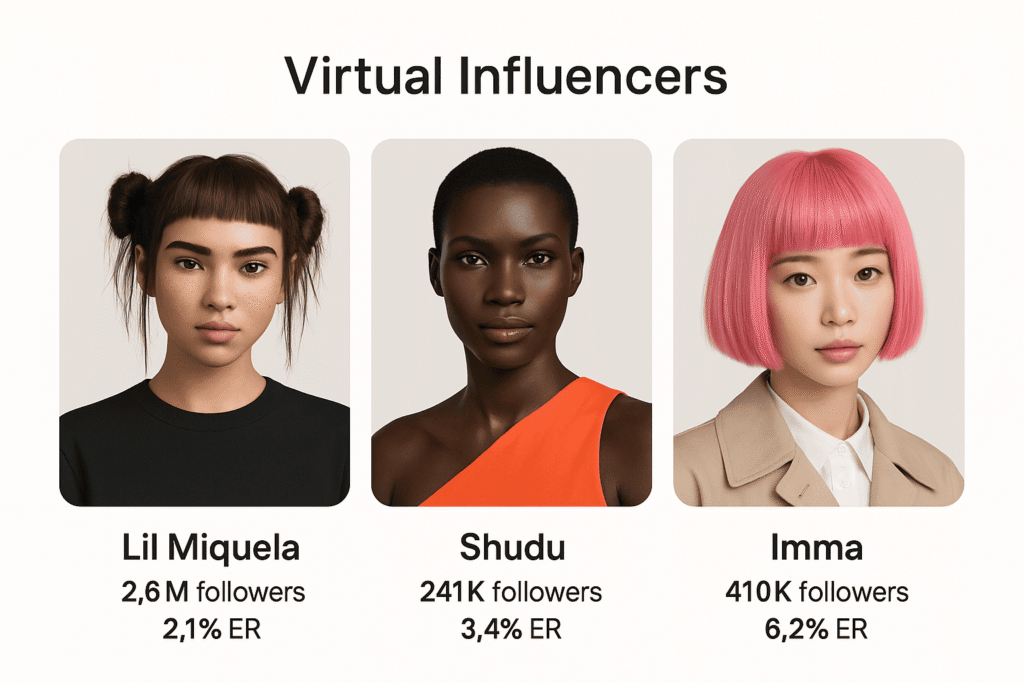
Meet Your New Influencer: They’re Not Human (and That’s the Point)
AI-generated influencers secure major fashion, beauty, and tech campaigns alongside human creators.
AI-generated influencers provide consistent brand messaging without controversies or missed deadlines.
Why brands are buying in:
- Engagement that rivals real influencers: Digital stars like Lil Miquela and Shudu pull in millions of followers, and the interaction isn’t just vanity metrics. Their audiences comment, share, and even build fandoms around them.
- Total creative control: From personality to visuals, brands can script every move, ensuring alignment down to the last emoji.
- Scalable and always-on: No flights, no time zone juggling, no burnout. These creators are available 24/7, globally, with no human limits.
AI influencers generate measurable marketing impact despite their synthetic nature.

Virtual influencers have 30% higher engagement rates on average than human influencers in sponsored posts, especially among Gen Z and younger millennial audiences who value futuristic, novelty-driven experiences.
Where they work best:
- Product launches in AR/VR environments
- Interactive digital fashion shows or app experiences
- Campaigns where visual perfection and narrative control are key
“Virtual influencers are not replacing humans—they’re redefining what’s possible in brand storytelling.”
AI-driven personas offer brands full creative control, endless scalability, and freedom from real-world creator unpredictability. Success depends on thoughtful implementation with transparency about their artificial nature to maintain audience trust.
From Mass Appeal to Micro-Communities
Influencer marketing in 2025 prioritizes targeted communication over broad reach. Success comes through micro-communities – tight-knit groups connected by shared values, lifestyles, and interests.
A sustainable skincare brand partnering with a micro-influencer educating Gen Z on clean beauty creates trusted conversation instead of traditional advertising.
Why micro-communities outperform mass influencers:
- Audiences feel seen and understood, not just marketed to.
- Content comes off as genuine and tailored, not generic.
- Engagement is deeper, and followers are more likely to comment, share, and take action on recommendations.
How to tap into this trend:
- Collaborate with niche influencers aligned with your target demo (e.g., tech-savvy moms, plant-based fitness enthusiasts, or slow fashion advocates).
- Prioritize shared values over pure aesthetic fit.
- Empower creators to build community-first content: think educational Reels, day-in-the-life tutorials, Q&As, or product challenges.
Connecting with relevant micro-communities builds brand loyalty and visibility among target audiences.
Short-Form Video: The Undisputed King of Engagement
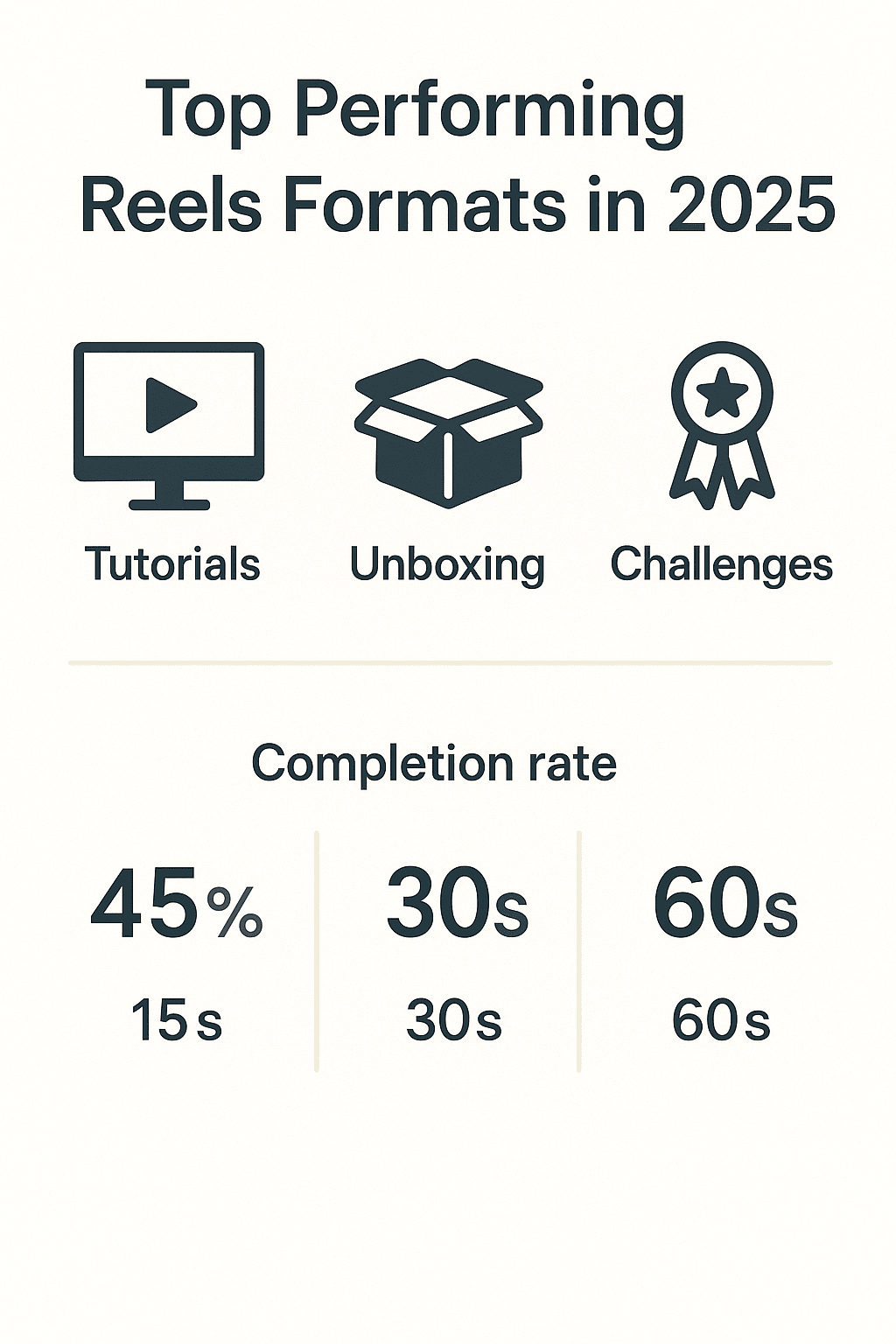
Short-Form Video Reigns Supreme on Instagram in 2025
Instagram in 2025 centers on Reels, with short-form video generating engagement. Users reward brands creating concise messages under 30 seconds while rapidly scrolling through content.
Static images remain relevant for brand aesthetics and long captions for storytelling, but short-form video dominates reach, ROI, and discovery metrics.
Why Reels Win Big:
- Instagram’s algorithm favors Reels—they show up first in Explore and get pushed harder in feeds.
- Mobile-first behavior rules. People want content that fits into their day, while commuting, waiting in line, or between tasks.
- Shorter attention spans = better performance. Videos under 60 seconds have a 150% higher completion rate than longer formats (Meta, 2025).
Formats That Work Right Now:
- Tutorial Reels
Creating Instagram influencer content involves tutorial Reels showing product usage, behind-the-scenes Stories that build authenticity, carousel posts for educational content, and unboxing videos that demonstrate genuine first reactions, which serves different stages of the customer journey from awareness to conversion through authentic storytelling that resonates with target audiences.
- Trend Mashups
Pair trending audio with your product in clever ways. Think memes, transitions, or relatable moments that feel native to the platform.
- Branded Challenges
Launch a Reel challenge with an influencer, get users involved, and amplify reach with user-generated content.
- Quick Demos & Unboxings
Highlight key features, do a before/after, or show the product in action. Keep it snappy, real, and scroll-stopping.
Want to go a step further? Pair your influencer Reels with paid boosting, Instagram’s Spark Ads equivalent for influencers to reach targeted audiences without relying solely on organic discovery.

Ask influencers to blend authenticity with storytelling, like showing “a day in the life” using your product or sharing their genuine first reaction.. Raw, unfiltered Reels often outperform polished ads.
“Don’t interrupt what people are interested in. Be what they’re interested in.”
What Brands Should Do Now
If Instagram is doubling down on video, your brand should follow suit.
- Shift your content mix: Prioritize short-form Reels, especially for product launches, flash sales, or seasonal drops. These moments thrive on urgency and shareability.
- Equip influencers to succeed: Give them branded filters, sounds, and visual cues to maintain consistency while letting their voice shine through.
- Track what matters: Monitor more than just likes. Optimize based on watch time, shares, saves, and retention rate. These signals real interest, not vanity engagement.
When you lean into Instagram’s video-first algorithm, you’re not just catching eyes—you’re converting attention into action.
Purpose-Driven Campaigns Are Winning Hearts (and Sales)
Successful influencer marketing in 2025 communicates brand purpose alongside products. Consumers prioritize brand values before making purchases.
Brands neglecting purpose-driven marketing sacrifice consumer loyalty and revenue potential.
Why This Shift Matters
- 72% of Gen Z and Millennials are more likely to buy from brands that align with causes they believe in
- Influencers who consistently speak about social or environmental values see up to 45% more engagement when promoting brands that align with their beliefs.
Real-World Examples of Purpose-Driven Influencer Campaigns:
- A skincare brand collaborates with eco-conscious creators to launch a plastic-free packaging initiative, paired with educational Reels about ocean waste.
- A jewelry label partners with mental health advocates, donating 10% of each sale during Mental Health Awareness Month, and inviting followers to share their self-care routines.
- A fashion brand creates a co-authored campaign with body-positive influencers, spotlighting slow fashion and garment worker rights.
“People don’t just want to buy what you make—they want to buy into why you make it.”
What Brands Should Start Doing:
- Choose influencers who walk the talk: Work with creators already advocating for social or environmental change, not those just hopping on cause-based trends.
- Tie campaigns to real-world impact: Whether it’s a donation, community project, or zero-waste production, make it meaningful, not performative.
- Share your results: Show how much was raised, who it helped, and what changed. Transparency earns trust (and shares).
Key Brand Benefits:
Purpose + authenticity → standout differentiation in a saturated market, solid tracking tools, and a reliable way to calculate ROI.
Emotional connection → long-term loyalty
Meaningful storytelling → organic word-of-mouth and PR pickup
Key Performance Indicators You Should Track
Campaign goals determine these measurement priorities:
| Objective | Primary KPIs | Secondary KPIs |
|---|---|---|
| Brand Awareness | Reach, Impressions, Follower Growth | Story Views, Profile Visits |
| Engagement | Engagement Rate, Comments, Saves | Share Rate, Comment Sentiment |
| Conversions | Click-through Rate, Conversion Rate, CPA | Average Order Value, Customer Lifetime Value |
Want to measure influencer engagement? Use this formula:
Engagement Rate = (Likes + Comments + Saves + Shares) ÷ Follower Count × 100
For context, nano-influencers (1K–10K followers) typically pull in a 4–5% engagement rate, often thanks to their tight-knit, loyal audiences. Macro-influencers (100K–1M) average closer to 1.3%, due to broader but less intimate reach.
Tip: Use UTMs and promo codes to track how many people clicked, purchased, or signed up from each influencer’s post.
Implementing Proper Attribution in Instagram Influencer Marketing
Proper attribution beyond engagement metrics identifies which influencers drive specific results, enabling strategic scaling of successful approaches.
1. Unique Promo Codes
Give each influencer their own discount code (like INFLUENCER20). It’s the easiest way to track direct sales—and gives you 100% attribution clarity on redemptions.
UTM Parameters
utm_source=instagram
utm_medium=influencer
utm_campaign=spring_sale
utm_content=alex_smith
Plug these into your analytics platform to see exactly who’s sending the clicks.
2. Instagram Shopping Tags
Using product tags in influencer posts? Smart move. Instagram Insights shows that tagged products get 35% higher conversion rates than links in bios. Always track those taps.
3. Custom Landing Pages
Build dedicated pages for each influencer, like:
recurpost.com/partner/alex-smith
This helps you analyze behavior, traffic sources, and conversions at the individual partner level.
4. Meta Pixel Tracking
Not every shopper buys right away. Add the Meta Pixel to your site to catch delayed conversions from influencer viewers. This alone can reveal up to 22% more attributable conversions that basic link tracking misses.
Calculating True ROI for Instagram Influencer Campaigns
ROI measures influencer marketing effectiveness using this formula:
ROI = [(Value of Conversions − Campaign Cost) ÷ Campaign Cost] × 100
Here’s an example:
- Campaign cost: $5,000 (5 influencers × $1,000 each)
- Conversions: 150 new customers
- Average order value (AOV): $85
- Total revenue: 150 × $85 = $12,750
- ROI: [(12,750 − 5,000) ÷ 5,000] × 100 = 155%
Brand awareness or engagement campaigns require valuing these upper-funnel metrics:
- 1,000 new followers = ~$500 (based on average organic acquisition costs)
- 10,000 engagements = ~$1,000 (equivalent to paid engagement rates)
- 100,000 impressions = ~$1,500 (based on CPM benchmarks)
Measuring upper-funnel actions justifies spending on campaigns building long-term brand equity.
Tools for Smarter Influencer Performance Tracking
Tools that streamline performance tracking and how they plug into RecurPost:
| Tool Type | Function | How RecurPost Helps |
|---|---|---|
| Native Instagram Analytics | See reach, impressions, saves, and story views | RecurPost pulls in key metrics for campaign reports |
| Google Analytics | Track influencer traffic and conversions | RecurPost visualizes GA data alongside content metrics |
| Link Shorteners (Bitly, etc.) | Monitor bio link clicks and UTM campaigns | RecurPost auto-generates and tracks shortened URLs |
| Influencer Platforms | Handle influencer CRM, contracts, payments | RecurPost complements with scheduling and analytics |
With RecurPost’s Analytics Dashboard, you get a single, unified view of your influencer efforts—engagement trends, growth spikes, post timing consistency, and more.
Case Study: How STYLE&CO Scored a 155% ROI with RecurPost
Fashion brand STYLE&CO ran a 4-week Instagram campaign featuring 8 micro-influencers, with RecurPost managing content delivery and tracking.
What They Did:
- Set up individual UTM links per influencer
- Built custom landing pages for attribution
- Issued unique promo codes to each influencer
- Used RecurPost to schedule posts and monitor performance
Results:
- 22,500 unique visitors from influencer content
- 450 conversions (2% CVR)
- $32,400 revenue generated
- 155% ROI on a $12,700 spend
- 3,200 new Instagram followers
RecurPost’s precise scheduling and performance reporting helped the brand boost ROI by 32% compared to their last campaign.
Common Mistakes That Sabotage Influencer ROI
These common mistakes reduce measurement accuracy and result scalability:
- Chasing vanity metrics (likes ≠ , revenue)
- Using only single-touch attribution, ignoring delayed or multi-channel impacts
- Inconsistent tracking across campaigns, making results unreliable
- Skipping baseline benchmarks, so you can’t compare before vs. after
- Manual data wrangling in spreadsheets instead of using smart automation
RecurPost users save an average of 5.5 hours per week on influencer reporting and get up to 28% more accurate attribution than those doing it manually.
Use Built-In & External Tools to Track Success
External tools centralize data beyond Instagram’s native insights for deeper campaign analysis.
Tools and what they help you measure:
Tool | What It Tracks |
Google Analytics 4 | On-site behavior, goal conversions, and session time |
Instagram Insights | Impressions, reach, shares, story taps |
Bitly / Rebrandly | CTRs and geographic traffic data |
Grin / Aspire / Upfluence | End-to-end influencer campaign ROI |
UTM.io | Custom UTM tracking made easy |
“You can’t optimize what you don’t measure.”
Benchmark Campaign Success—Then Optimize
Evaluate success by comparing campaign data against industry benchmarks and past performance.
Benchmarks to consider:
- Industry average engagement rates (e.g., ~2% for macro influencers, ~5–8% for micro influencers)
- Cost-per-engagement (CPE) norms based on niche and tier
- Typical influencer ROI (many brands aim for $5+ return per $1 spent)
Next steps for optimization:
- A/B test different influencer styles (UGC vs pro content)
- Repurpose top-performing influencer content for ads
- Double down on creators with high ROIS
- Cut underperformers or renegotiate contracts
Tracking the right KPIs empowers you to turn an influencer marketing campaign strategy from a hopeful experiment into a predictable growth engine.
Conclusion: Make Influence Count, Not Just Impressions
Instagram influencer marketing requires authenticity, strategic planning, and measurable outcomes with success depending on precise influencer selection, content co-creation, and data utilization.
Prioritize long-term relationships, niche communities, and ROI-backed decisions over vanity metrics by building influence with intention rather than pursuing visibility alone.
Ready to elevate your next campaign? Start smart, scale fast, and let your impact speak louder than your reach.
Frequently Asked Questions
1. Is Instagram influencer marketing still effective in 2025?
Yes, Instagram influencer marketing remains highly effective in 2025, especially with the rise of micro and nano influencers. Engagement rates are higher when brands focus on niche communities rather than follower counts. Authenticity and relatable storytelling drive conversions more than polished ads.
2. How do I find the right influencer for my brand on Instagram?
Start by defining your audience, goals, and budget, then use tools like Heepsy, Modash, or Instagram’s built-in Collab features. Look beyond follower count to engagement rate, content style, and audience demographics. Always prioritize brand fit and audience trust over vanity metrics.
3. What’s the average ROI of Instagram influencer campaigns in 2025?
According to Tomoson’s influencer marketing study, the average ROI is $5.78 for every $1 spent, but top-performing campaigns can go even higher. Results depend on your targeting, influencer alignment, and campaign structure. Performance-based deals and UGC repurposing often boost ROI significantly.
4. What influencer marketing trends are shaping Instagram in 2025?
UGC-style content, AI-powered influencers, long-term partnerships, and cause-driven storytelling are dominating. Collaborative posts, Instagram Reels, and performance-based campaigns are gaining traction. Transparency, value alignment, and content quality matter more than ever.
5. Should I work with micro or macro influencers in 2025?
Micro-influencers (10k–100k followers) often deliver better engagement and trust, especially in niche markets. Macro influencers are great for reach and awareness, but may lack a tight-knit community impact. A hybrid strategy works best for most brands, mixing both depending on campaign goals.
6. How much do Instagram influencers charge in 2025?
Pricing varies, but micro-influencers typically charge between $100–$1,000 per post, while top-tier creators can demand $10,000+. Costs also depend on content format (Reels vs. Stories), exclusivity, usage rights, and campaign duration. Always negotiate based on deliverables, not just followers.

Fenil Patel is a content writer specializing in social media marketing. He creates engaging, results-driven content that helps brands grow online, connect with audiences, and boost digital visibility. With a sharp eye for trends and strategy, he turns ideas into content that performs. Fenil is passionate about helping businesses stand out in the fast-paced world of digital marketing.
